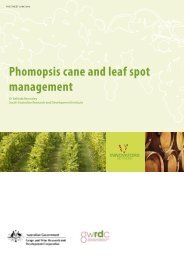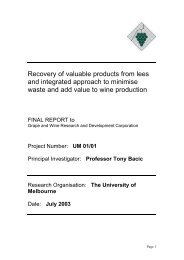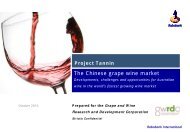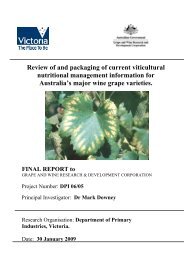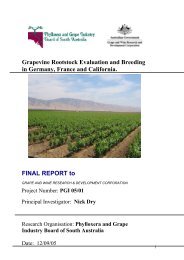Identification of the major drivers of 'phenolic' taste in ... - GWRDC
Identification of the major drivers of 'phenolic' taste in ... - GWRDC
Identification of the major drivers of 'phenolic' taste in ... - GWRDC
You also want an ePaper? Increase the reach of your titles
YUMPU automatically turns print PDFs into web optimized ePapers that Google loves.
AWRI: <strong>Identification</strong> Of The Major Drivers Of ‘Phenolic’ Taste In White W<strong>in</strong>es<br />
6.2.2 Tast<strong>in</strong>g Panel<br />
N<strong>in</strong>e <strong>taste</strong>rs (five males and 4 females) were tra<strong>in</strong>ed for this study. They were drawn from a group <strong>of</strong><br />
people with considerable experience <strong>in</strong> pr<strong>of</strong>il<strong>in</strong>g w<strong>in</strong>e aroma, flavour and <strong>the</strong> <strong>taste</strong> sensations <strong>of</strong> bitterness<br />
and acidity. While some <strong>taste</strong>rs were experienced <strong>in</strong> assess<strong>in</strong>g <strong>the</strong> astr<strong>in</strong>gency <strong>of</strong> red w<strong>in</strong>es, none had<br />
previously assessed phenolic <strong>taste</strong>s <strong>in</strong> white w<strong>in</strong>e.<br />
Tasters had been previously accepted for panel membership on <strong>the</strong> basis <strong>of</strong> <strong>the</strong>ir general sensory acuity<br />
<strong>in</strong>clud<strong>in</strong>g sensitivity to <strong>the</strong> bitter tast<strong>in</strong>g qu<strong>in</strong><strong>in</strong>e sulfate (15 mg/L) (ISO 8586). Tasters were fur<strong>the</strong>r<br />
screened just prior to <strong>the</strong> trial for <strong>the</strong>ir sensitivity to bitterness elicited by 3.2 mM 6-n-propylthiouracil<br />
(PROP). An aqueous solution <strong>of</strong> <strong>the</strong> compound was rated for bitterness us<strong>in</strong>g a labeled magnitude<br />
estimation scale. As this scale has been shown to exhibit ratio properties, <strong>the</strong> data showed that <strong>the</strong> <strong>taste</strong>rs<br />
differed around three-fold <strong>in</strong> <strong>the</strong>ir perception <strong>of</strong> bitterness. Despite this expected variation <strong>in</strong> bitterness<br />
sensitivity, <strong>the</strong> <strong>in</strong>itial screen<strong>in</strong>g us<strong>in</strong>g qu<strong>in</strong><strong>in</strong>e sulfate suggested that all <strong>of</strong> <strong>the</strong> <strong>taste</strong>rs <strong>in</strong>volved <strong>in</strong> <strong>the</strong> study<br />
were adequately able to detect bitterness.<br />
6.2.3 Taster Tra<strong>in</strong><strong>in</strong>g<br />
A two hour tra<strong>in</strong><strong>in</strong>g session was used to arrive at descriptors and def<strong>in</strong>itions for <strong>the</strong> textural sensations<br />
associated with <strong>the</strong> fractions. The tra<strong>in</strong><strong>in</strong>g examples that were <strong>taste</strong>d and discussed were 1) a commercial<br />
unwooded McLaren Vale Chardonnay that had been extensively stripped <strong>of</strong> its phenolics us<strong>in</strong>g Amberlite<br />
FPX-66 res<strong>in</strong> (<strong>the</strong> base w<strong>in</strong>e), 2) <strong>the</strong> base w<strong>in</strong>e with its whole phenolics added back, and 3) <strong>the</strong> base w<strong>in</strong>e<br />
plus <strong>the</strong> whole phenolics extracted from an Adelaide Hills Chardonnay. The base w<strong>in</strong>e was <strong>the</strong> same as<br />
that used <strong>in</strong> <strong>the</strong> formal assessment <strong>of</strong> <strong>the</strong> phenolic fractions.<br />
The attributes, astr<strong>in</strong>gency, bitterness, viscosity, burn<strong>in</strong>g, acidity (<strong>in</strong> mouth) and acidity after<strong>taste</strong> (AT)<br />
were agreed upon by <strong>the</strong> <strong>taste</strong>rs as adequately represent<strong>in</strong>g <strong>the</strong> samples presented dur<strong>in</strong>g tra<strong>in</strong><strong>in</strong>g. The<br />
agreed def<strong>in</strong>ition <strong>of</strong> <strong>the</strong> terms is given <strong>in</strong> Appendix B, Table B-3.<br />
6.2.4 Formal Assessment<br />
Tast<strong>in</strong>gs were conducted <strong>in</strong> triplicate, one week apart. Dur<strong>in</strong>g each session, all 13 treatment comb<strong>in</strong>ations<br />
<strong>in</strong>clud<strong>in</strong>g <strong>the</strong> control were presented <strong>in</strong> a randomised order to each assessor. The fractions were added to<br />
a one year old unwooded McLaren Vale Chardonnay (<strong>the</strong> same w<strong>in</strong>e used <strong>in</strong> Chapter 3) that had been<br />
extensively stripped <strong>of</strong> its phenolics by <strong>the</strong> Amberlite FPX-66 res<strong>in</strong>. 30 mL <strong>of</strong> sample were <strong>taste</strong>d from<br />
ISO w<strong>in</strong>e tast<strong>in</strong>g glasses at room temperature and under amber light<strong>in</strong>g. Tasters assessed <strong>the</strong> <strong>in</strong>tensity <strong>of</strong><br />
astr<strong>in</strong>gency, bitterness, acidity, viscosity and ‘burn<strong>in</strong>g’ us<strong>in</strong>g a 15 cm partially structured l<strong>in</strong>e scale as<br />
described previously. Assessors were asked to r<strong>in</strong>se <strong>the</strong>ir mouth with water and were required to wait two<br />
m<strong>in</strong>utes before tast<strong>in</strong>g <strong>the</strong> follow<strong>in</strong>g sample, and to rest for 15 m<strong>in</strong>utes after every fourth sample. The<br />
ballots were served to <strong>taste</strong>rs by <strong>the</strong> FIZZ v 2.46 sensory data acquisition s<strong>of</strong>tware (Biosystèmes,<br />
Couternon).<br />
Page | 47




